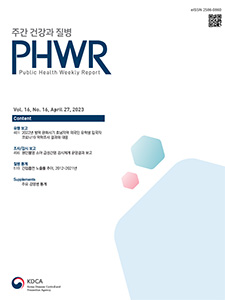Current Issue
Vol.16 No.16, April 27, 2023
-
Outbreak Reports 2023-04-27
 0
0
 2128
2128
 387
387
2022 Quarantine Relaxation Period Foreign Students Entering Honam COVID-19 Epidemiological Survey Results and Response
Eunyoung Kim, Seung-Jin Kim, Aejung Lee, Jeonghee Yu*
Public Health Weekly Report 2023; 16(16): 481-495 https://doi.org/10.56786/PHWR.2023.16.16.1 Abstract
AbstractThis report is an investigation of the outbreak of coronavirus disease 2 019 (COVID-19) among participants in a foreign students’ class program at a local Korean university in December 2022, during the relaxation period of COVID-19 prevention. It also describes the measures and analyses of 143 confirmed cases among 256 international students of Chinese nationality who entered the country during the period and four confirmed cases among 41 existing residents. The incidence was higher in men (53.8%) than in women, with 100%, 57.3%, 42.3%, and 26.3% incidences among individuals in their 50s, 30s, 40s, and 20s, respectively. Regarding vaccination, 59.1% of the participants had received the second dose and 48.7% had received the third dose or more. The incidence rate of COVID-19 for international arrivals among the investigated confirmed cases was 97.2%, and mutation analysis of these samples showed the presence of subvariants such as BA.5 61.5%, BQ.1 14.7%, and BN.1 2.3% among the Omicron subsystems; subvariant BA.2.75 or new variants were not identified. Regarding the period from the date of entry to the date of confirmation, 109 (42.6%) cases were confirmed within 10 days of passive surveillance after entering the country, of which 82 (32.0%) were confirmed within 2–3 days and were presumed to be infected before entering the country. Thirty cases were confirmed after 10 days. Furthermore, four existing arrivals had contact with confirmed positive individuals; therefore, further transmission was considered possible. Preemptive tests and thorough management were found to minimize further COVID-19 influx into the community, and the continuous monitoring of overseas outbreaks and adjustment of the strength of quarantine policies have an important impact on case management.
-
Surveillance Reports 2023-04-27
 0
0
 617
617
 139
139
Result of the Surveillance System for Acute Hepatitis of Unknown Etiology in Children in the Republic of Korea
Eunkyung Park, Soonryu Seo, Jin Gwack*
Public Health Weekly Report 2023; 16(16): 496-518 https://doi.org/10.56786/PHWR.2023.16.16.2 Abstract
AbstractAcute hepatitis of unknown etiology was reported to be increasing in cases under the age of 10 in the UK Health Security Agency in April 2022, and probable cases have been reported in many countries such as the UK and the United States. The Korea Disease Control and Prevention Agency established a surveillance system for acute hepatitis of unknown etiology in children for approximately seven months, from May 1 to December 2, 2022 in cooperation with experts and related societies to identify the domestic outbreak situation and determine the causes. A case of acute hepatitis of unknown etiology in children in the Republic of Korea (ROK) was defined as a person presenting with acute hepatitis (non-hepatitis viruses A, B, C, and E) with serum transaminase levels greater than 500 IU/L (aspartate aminotransferase [AST] or alanine aminotransferase [ALT]), aged 16 years or older, since May 1, 2022. A total of 82 cases, excluding a case that did not meet the case definition, were identified as 66 cases met the case definition, and 16 cases could not be evaluated. 12 (14.6%) and 4 (4.9%) cases tested positive for adenovirus and adeno-associated virus type 2 using polymerase chain reaction testing, respectively. Four cases (4.9%) underwent liver transplantation, wherein no death occurred. Additionally, no specific trend by time or season was identified regarding the outbreak in the ROK.
-
QuickStats 2023-04-27
 0
0
 670
670
 125
125
Trends in the Prevalence of Secondhand Smoke Exposure, 2012–2021
Public Health Weekly Report 2023; 16(16): 519-520 https://doi.org/10.56786/PHWR.2023.16.16.3

pp. 1433~1461
Most Keyword
?
What is Most Keyword?
- It is the most frequently used keyword in articles in this journal for the past two years.
Most Read
-
Waterborne and Foodborne Disease Outbreaks in the Republic of Korea, 2023
Myung-Jae Hwang, So Yeon Park, Hyungjun Kim, Se Jeong Yang, Sungchan Yang, Jin Seon Yang
Public Health Weekly Report 2025;18: 17-32 https://doi.org/10.56786/PHWR.2025.18.1.2 -
Implementation Plan for the Coronavirus Disease 2019 Vaccination for the 2024–2025 Season: Recommendations of the 6th Expert Committee on Immunization Practices
Hyewook Hwang, Wookeon Lee, Seohyeon Ahn, Young-Sook Choi, Seunghyun Lewis Kwon, Dongwoo Lee, Eun Hwa Choi, SokGoo Lee
Public Health Weekly Report 2025;18: 90-102 https://doi.org/10.56786/PHWR.2025.18.2.3
Editorial Office
+82-43-719-7569





 Full Text
Full Text Cite
Cite


